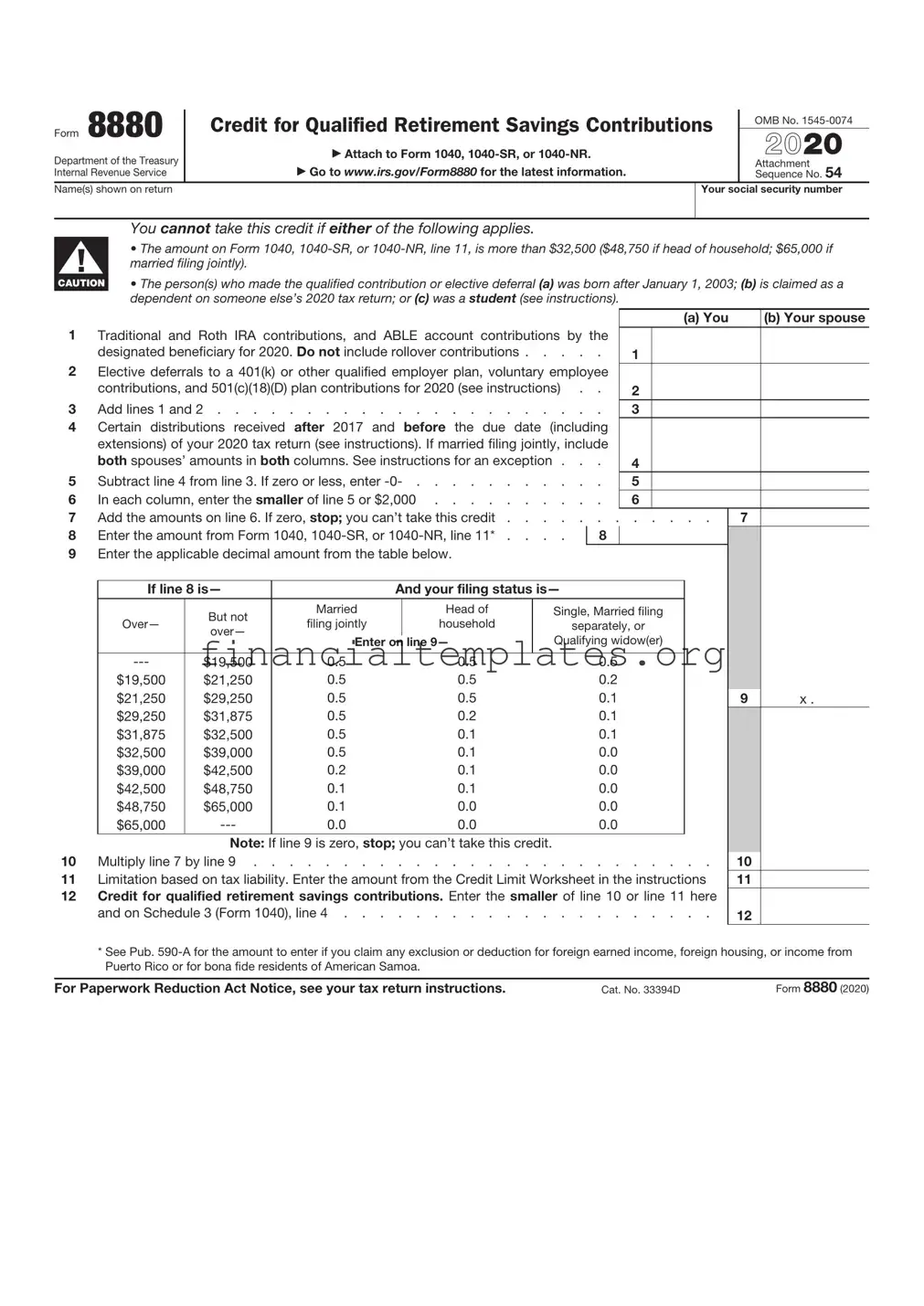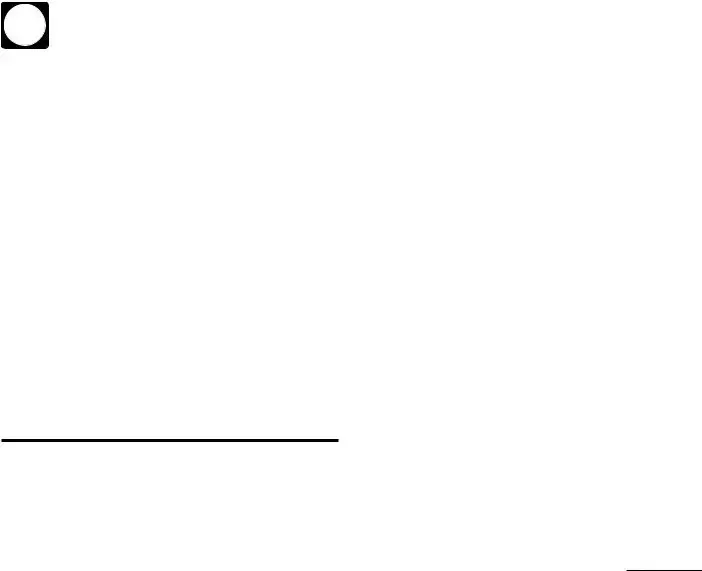General Instructions
Section references are to the Internal Revenue Code.
Reminder
Contributions by a designated beneficiary to an Achieving a Better Life Experience (ABLE) account. A retirement savings contribution credit may be claimed for the amount of contributions you, as the designated beneficiary of an ABLE account, make before January 1, 2026, to the ABLE account. See Pub. 907, Tax Highlights for Persons With Disabilities, for more information.
Future Developments
For the latest information about developments related to Form 8880 and its instructions, such as legislation enacted after they were published, go to www.irs.gov/Form8880.
Purpose of Form
Use Form 8880 to figure the amount, if any, of your retirement savings contributions credit (also known as the saver’s credit).
TIP |
This credit can be claimed in addition to any IRA deduction |
claimed on Schedule 1 (Form 1040), line 20. |
Who Can Take This Credit
You may be able to take this credit if you, or your spouse if filing jointly, made (a) contributions (other than rollover contributions) to a traditional or Roth IRA; (b) elective deferrals to a 401(k), 403(b), governmental 457(b), SEP, SIMPLE, or to the federal Thrift Savings Plan (TSP); (c) voluntary employee contributions to a qualified retirement plan, as defined in section 4974(c) (including the federal TSP); (d) contributions to a 501(c)(18)(D) plan; or (e) contributions, as a designated beneficiary of an ABLE account, to the ABLE account, as defined in section 529A.
However, you can’t take the credit if either of the following applies.
•The amount on Form 1040, 1040-SR, or 1040-NR, line 11, is more than $33,000 ($49,500 if head of household; $66,000 if married filing jointly).
•The person(s) who made the qualified contribution or elective deferral
(a) was born after January 1, 2004; (b) is claimed as a dependent on someone else’s 2021 tax return; or (c) was a student.
You’ll need to refigure the amount on Form 1040 or ▲! 1040-SR, line 11, if you’re filing Form 2555 or Form 4563 or
you’re excluding income from Puerto Rico. See Pub. 590-A CAUTION at www.irs.gov/Pub590A for details.
You were a student if during any part of 5 calendar months of 2021 you:
•Were enrolled as a full-time student at a school; or
•Took a full-time, on-farm training course given by a school or a state, county, or local government agency.
A school includes technical, trade, and mechanical schools. It doesn’t include on-the-job training courses, correspondence schools, or schools offering courses only through the Internet.
Specific Instructions
Column (b)
Complete column (b) only if you’re filing a joint return.
Line 2
Include on line 2 any of the following amounts.
•Elective deferrals (including designated Roth contributions under section 402A, if applicable) to a 401(k), 403(b), governmental 457(b), SEP, SIMPLE, or to the federal TSP.
•Voluntary employee contributions to a qualified retirement plan, as defined in section 4974(c) (including the federal TSP).
•Contributions to a 501(c)(18)(D) plan.
These amounts may be shown in box 12 of your Form(s) W-2 for 2021.
Note: Contributions designated under section 414(h)(2) are treated as employer contributions and, as such, they aren’t voluntary contributions made by the employee. They don’t qualify for the credit and shouldn’t be included on line 2.
Line 4
Enter the total amount of distributions you, and your spouse if filing jointly, received after 2018 and before the due date of your 2021 return (including extensions) from any of the following types of plans.
•Traditional or Roth IRAs, or ABLE accounts.
•401(k), 403(b), governmental 457(b), 501(c)(18)(D), SEP, SIMPLE, or to the federal TSP.
•Qualified retirement plans, as defined in section 4974(c).
Don’t include any of the following.
•Distributions not taxable as the result of a rollover or a trustee-to- trustee transfer.
•Distributions that are taxable as the result of an in-plan rollover to your designated Roth account.
•Distributions from your eligible retirement plan (other than a Roth IRA) rolled over or converted to your Roth IRA.
•Loans from a qualified employer plan treated as a distribution.
•Distributions of excess contributions or deferrals (and income allocable to such contributions or deferrals).
•Distributions of contributions made to an IRA during a tax year and returned (with any income allocable to such contributions) on or before the due date (including extensions) for that tax year.
•Distributions of dividends paid on stock held by an employee stock ownership plan under section 404(k).
•Distributions from a military retirement plan (other than the federal TSP).
•Distributions from an inherited IRA by a nonspousal beneficiary.
If you’re filing a joint return, include both spouses’ amounts in both columns.
Exception. Don’t include your spouse’s distributions with yours when entering an amount on line 4 if you and your spouse didn’t file a joint return for the year the distribution was received.
Example. You received a distribution of $5,000 from a qualified retirement plan in 2021. Your spouse received a distribution of $2,000 from a Roth IRA in 2019. You and your spouse file a joint return in 2021, but didn’t file a joint return in 2019. You would include $5,000 in column
(a)and $7,000 in column (b).
Line 7
Add the amounts from line 6, columns (a) and (b), and enter the total.
Line 11
Before you complete the following worksheet, figure the amount of any credit for the elderly or the disabled you’re claiming on Schedule 3 (Form 1040), line 6d. See Schedule R (Form 1040) to figure the credit.
Credit Limit Worksheet
Complete this worksheet to figure the amount to enter on line 11.
1.Enter the amount from Form 1040, 1040-SR, or
2. Form 1040, 1040-SR, or 1040-NR filers: Enter
|
the total of your credits from Schedule 3, lines 1 |
2. |
|
through 3, 6d, and 6l |
|
|
|
3.Subtract line 2 from line 1. Also enter this amount on Form 8880, line 11. But if zero or less, stop;
you can’t take the credit—don’t file this form . |
3. |
|
|
|
|


